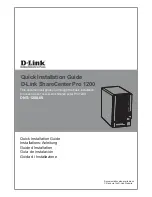
xStack DGS/DXS-3300 Series Layer 3 Stackable Gigabit Ethernet Switch CLI Manual
298
38
PIM C
OMMANDS
PIM or
Protocol Independent Multicast
is a method of forwarding traffic to multicast groups over the network using any pre-
existing unicast routing protocol, such as RIP or OSPF, set on routers within a multicast network. The xStack DGS/DXS-3300
series supports two types of PIM, Dense Mode (PIM-DM) and Sparse Mode (PIM-SM).
PIM-SM
PIM-SM or
Protocol Independent Multicast – Sparse Mode
is a method of forwarding multicast traffic over the network only to
multicast routers who actually request this information. Unlike most multicast routing protocols which flood the network with
multicast packets, PIM-SM will forward traffic to routers who are explicitly a part of the multicast group through the use of a
Rendezvous Point (RP). This RP will take all requests from PIM-SM enabled routers, analyze the information and then returns
multicast information it receives from the source, to requesting routers within its configured network. Through this method, a
distribution tree is created, with the RP as the root. This distribution tree holds all PIM-SM enabled routers within which
information collected from these router is stored by the RP.
Two other types of routers also exist with the PIM-SM configuration. When many routers are a part of a multiple access
network, a Designated Router (DR) will be elected. The DR’s primary function is to send Join/Prune messages to the RP. The
router with the highest priority on the LAN will be selected as the DR. If there is a tie for the highest priority, the router with the
higher IP address will be chosen.
The third type of router created in the PIM-SM configuration is the Boot Strap Router (BSR). The goal of the Boot Strap Router
is to collect and relay RP information to PIM-SM enabled routers on the LAN. Although the RP can be statically set, the BSR
mechanism can also determine the RP. Multiple Candidate BSRs (C-BSR) can be set on the network but only one BSR will be
elected to process RP information. If it is not explicitly apparent which C-BSR is to be the BSR, all C-BSRs will emit Boot
Strap Messages (BSM) out on the PIM-SM enabled network to determine which C-BSR has the higher priority and once
determined, will be elected as the BSR. Once determined, the BSR will collect RP data emanating from candidate RPs on the
PIM-SM network, compile it and then send it out on the land using periodic Boot Strap Messages (BSM). All PIM-SM Routers
will get the RP information from the Boot Strap Mechanism and then store it in their database.
Discovering and Joining the Multicast Group
Although Hello packets discover PIM-SM routers, these routers can only join or be “pruned” from a multicast group through the
use of Join/Prune Messages exchanged between the DR and RP. Join/Prune Messages are packets relayed between routers that
effectively state which interfaces are, or are not to be receiving multicast data. These messages can be configured for their
frequency to be sent out on the network and are only valid to routers if a Hello packet has first been received. A Hello packet
will simply state that the router is present and ready to become a part of the RP’s distribution tree. Once a router has accepted a
member of the IGMP group and it is PIM-SM enabled, the interested router will then send an explicit Join/Prune message to the
RP, which will in turn route multicast data from the source to the interested router, resulting in a unidirectional distribution tree
for the group. Multicast packets are then sent out to all nodes on this tree. Once a prune message has been received for a router
that is a member of the RP’s distribution tree, the router will drop the interface from its distribution tree.
Distribution Trees
Two types of distribution trees can exist within the PIM-SM protocol, a Rendezvous-Point Tree (RPT) and a Shortest Path Tree
(SPT). The RP will send out specific multicast data that it receives from the source to all outgoing interfaces enabled to receive
multicast data. Yet, once a router has determined the location of its source, an SPT can be created, eliminating hops between the
source and the destination, such as the RP. This can be configured by the switch administrator by setting the multicast data rate
threshold. Once the threshold has been passed, the data path will switch to the SPT. Therefore, a closer link can be created
between the source and destination, eliminating hops previously used and shortening the time a multicast packet is sent from the
source to its final destination.
















































